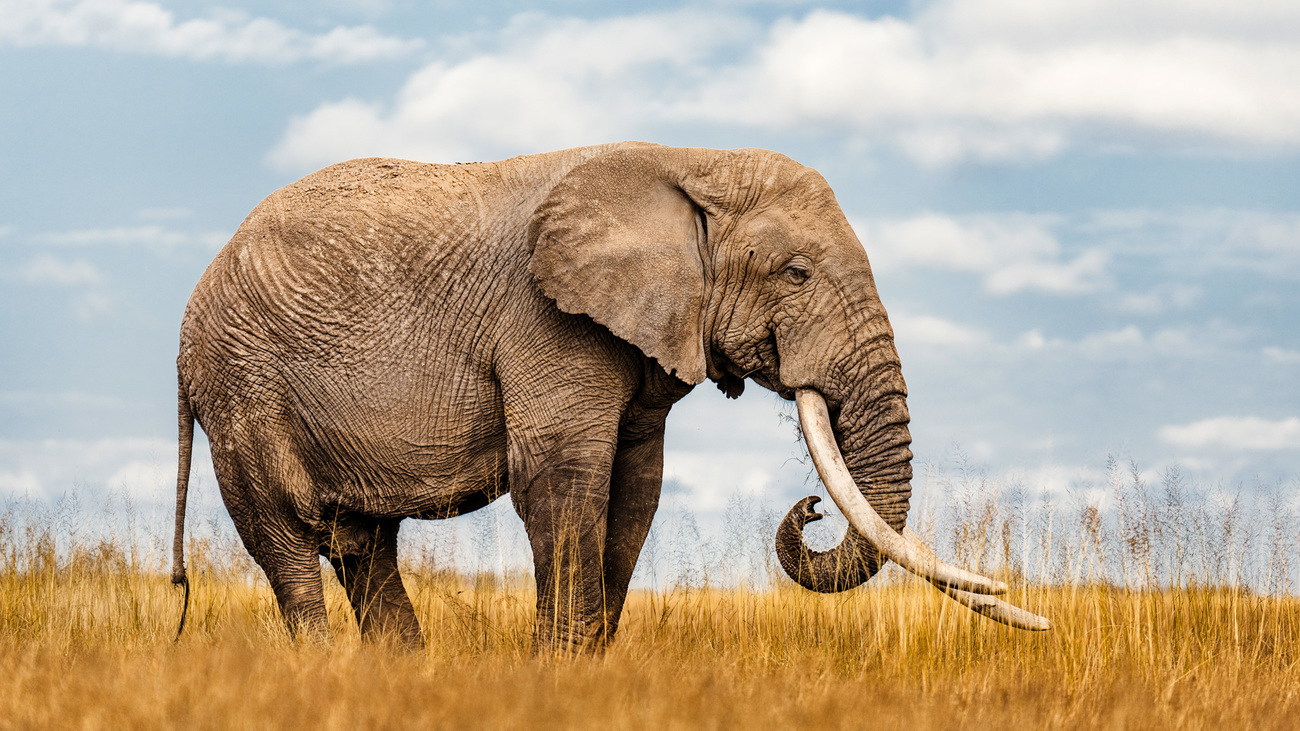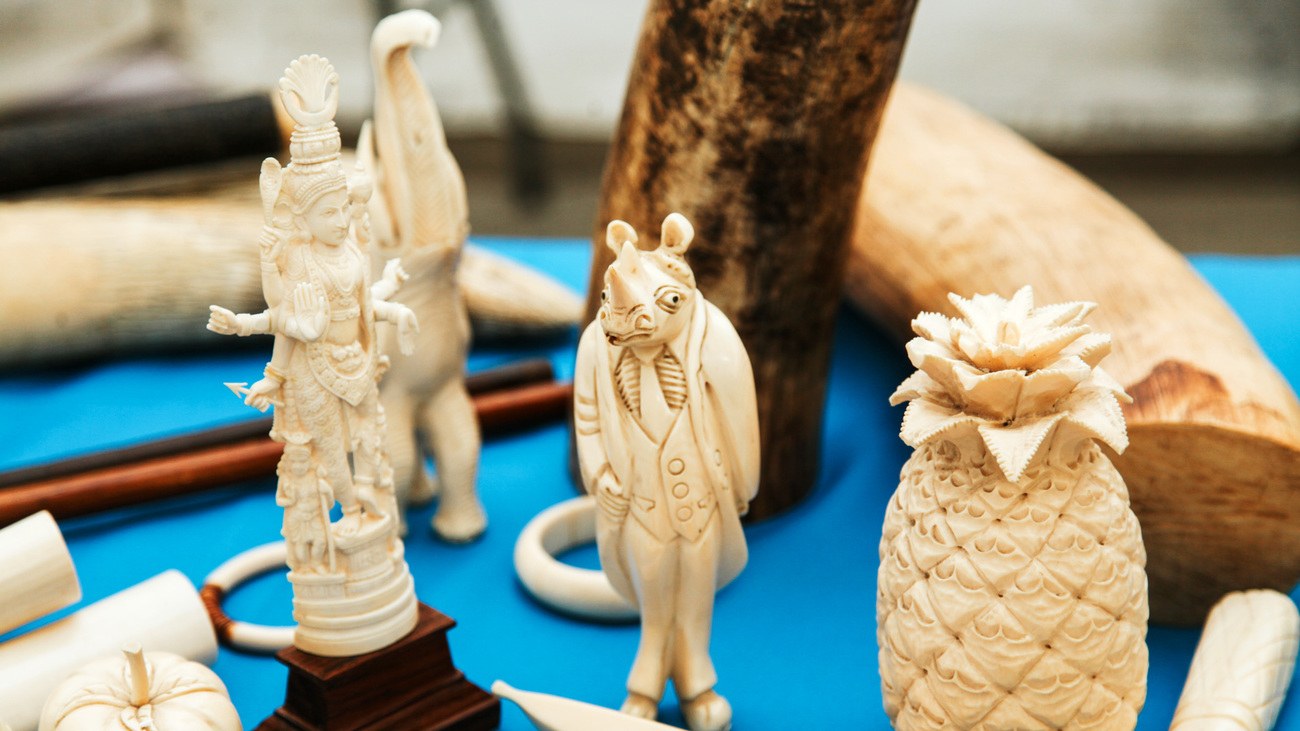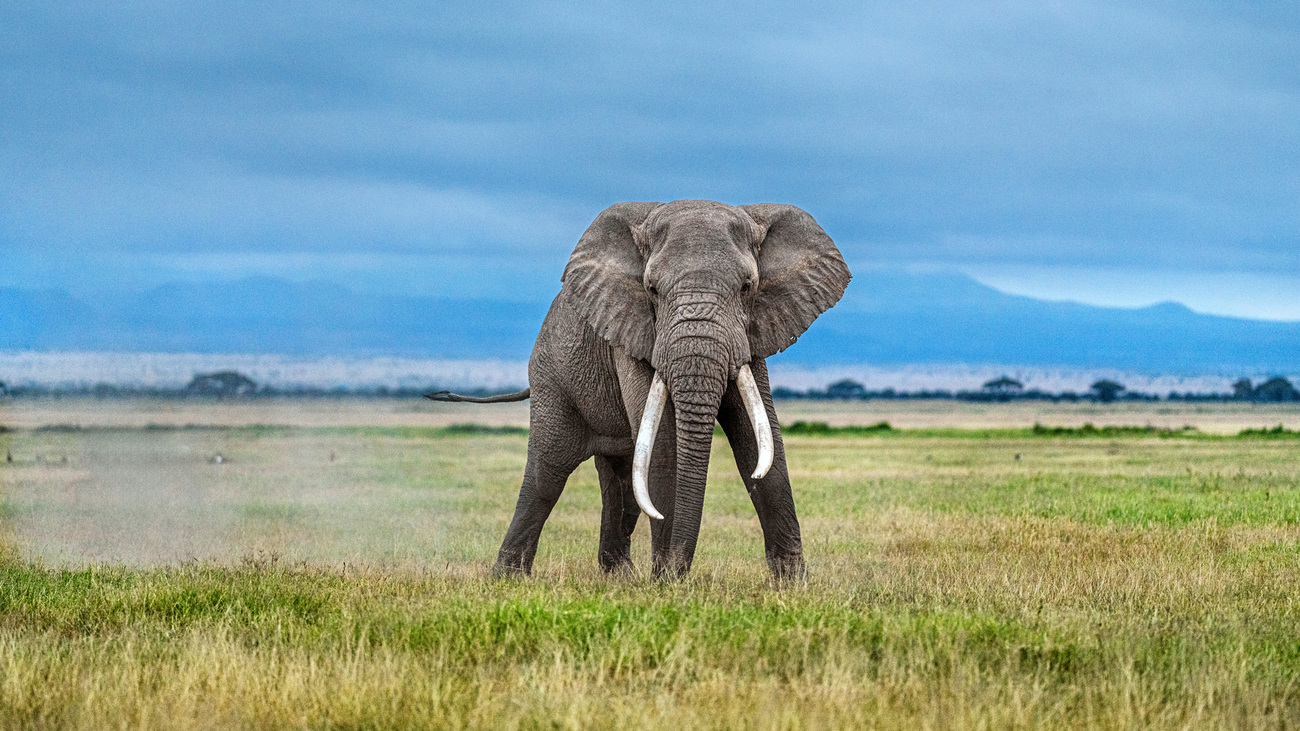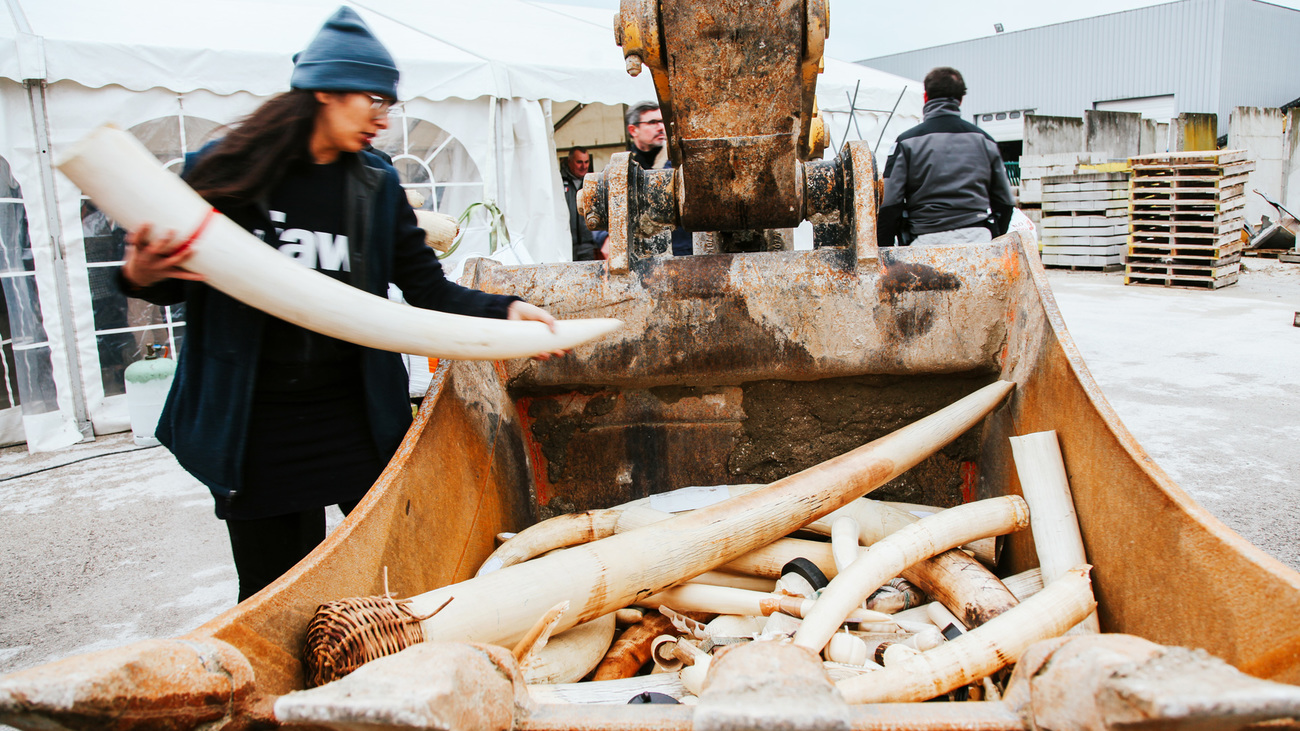What first comes to mind when you think of elephants? Is it their big ears or long trunks? Or maybe their iconic tusks that give them an appearance of majesty and strength? These tusks are made of ivory, a cream-coloured dense bone tissue that surrounds enamel. Elephants use them for a variety of purposes, including foraging, fighting, and protection. Devastatingly, an elephant’s tusks are also what makes them a target for poachers. But why is ivory so valuable, and how can we prevent the senseless killing of elephants driven by the ivory trade? Here are the fast facts.

Which animals have ivory?
Elephants are the animal most known for their ivory, but other animals like the walrus, hippopotamus, narwhal, sperm whale, and warthog also have tusks or teeth that are made up of a similar chemical structure. The word ivory is used to identify any mammalian tooth or tusk that is of commercial interest, with elephant tusks being the most sought after due to their large size.
What is ivory made of?
Ivory is made of dense bone tissue that surrounds enamel. More specifically, it is a form of dentin, which is the hard material that makes up the bulk of teeth.
Unlike antlers that are shed annually, tusks evolved from upper incisor teeth and continually grow over the course of the animal’s lifetime. As the tusks grow, layers of ivory are added over time, growing over the previous outer layer.
The head end of an elephant’s tusk is hollow but becomes more solid towards the tip. From about the centre point of the tusk, there is a narrow nerve canal running down to the tip. This means that tusks are sensitive, and it is extremely painful for the animals if they are removed.
What is ivory used for, and why is it seen as valuable?
Ivory has had many uses over the years. Due to its porous and malleable nature, it can be used to craft a number of items. These might be everyday objects such as tools, jugs, and tableware. However, ivory is most often used as a status symbol and is therefore reserved for luxury goods rather than necessities. It is common to see small statues, figurines, and carvings made from ivory. Ivory chess sets, jewellery, and piano keys are all also seen as signs of wealth and status.

Additionally, ivory is used as a form of traditional medicine in many parts of the world. Typically, the ivory is powdered and then used to treat a variety of ailments. In Chinese traditional medicine, for example, it is said that ivory can purge the body of toxins and enhance the complexion. However, there is no scientific evidence to support ivory’s medicinal use.
African carvings made from ivory
Historically, the use of ivory in Africa was very limited and did not put elephant populations at risk. It was only used for individuals of high status in African societies and was seen as a symbol of power and wealth. Typically, ivory was used for carvings, and, without modern tools, ivory carving was a specialised trade.
It wasn’t until the 19th century, when the ivory trade became more widespread across the world, that elephants began to be hunted at dangerous levels. The increased demand for ivory by rulers and the wealthy around the world led to the overhunting and decline of elephant populations.
History of the ivory trade
The ivory trade has a long history stretching back to ancient Rome. In Roman times, elephants were hunted for their ivory, as well as being used in gladiator fights and as weapons of war. The North African elephant was hunted to extinction in the 4th century, putting a stop to the ivory trade at that time.
Unfortunately, the trade didn’t stop for very long. Roughly 500 years later, ivory was being transported from West and East Africa further north and to the Middle East. From there, the ivory was exported all over the world, to Asia, the Mediterranean, and Europe.
From the 1500s onward, with the advances in technology and the establishment of trade routes and colonies, the ivory trade exploded. However, diseases such as sleeping sickness meant that foreign hunters were unable to travel across Africa to hunt elephants themselves. Instead, the majority of ivory came from African hunters, who had to travel further and further inland to find elephants as coastal populations had already been decimated. This, at least, limited the impact of elephant hunting on a continental scale, despite the increasing demand for ivory.
In the 1800s, though, technological, scientific, and medical advances meant that the ivory trade could once again accelerate. Now, hunters from around the world were able to journey into the African heartlands to hunt elephants themselves, leading to a considerable decline in numbers. Despite laws being passed in the early 1900s to curb hunting, licences were still available to the wealthy.
Throughout the 20th century, more laws were passed to eliminate the ivory trade. It is now illegal to trade ivory for commercial purposes in all African countries except Botswana, South Africa, Zimbabwe, and Namibia, where special export licences are required.
Is it illegal to buy and sell ivory?
The international sale of ivory was banned by the Convention on International Trade in Endangered Species of Wild Fauna and Flora (CITES) in 1989, but domestic trade still remained legal in many countries. In the last decade, the US, France, the UK, China, Belgium, the Netherlands, Luxembourg, Singapore, and a handful of other countries have passed stricter laws on the ivory trade.
However, prescribed conditions that give certain ivory exceptions to the rules, such as the antique ivory (pre-1947), pre-convention worked ivory (acquired before the date on which CITES or the EU Wildlife Trade Regulations became applicable), and raw ivory, are complicating the matter.
New ivory is also being illegally sold under these exemptions, making the issue even more complex. Any trade in ivory, even where legal, causes consumer and enforcement confusion and provides a cover for the laundering of illegally-sourced ivory.
The ivory trade today
Although the trade of ivory is heavily restricted today, critics say that any legal form of ivory trade encourages illegal poaching—and, as a result, trade in ivory is still very lucrative.
In fact, it is estimated that the ivory trade is worth approximately US $23 billion worldwide each year, despite the restrictions. Much of this trade is through the poaching of elephants, with poachers using many tactics to subvert laws, such as artificially ageing ivory.
FAQs
Do elephants feel pain if their tusks are removed?
Elephants are usually killed before their tusks are removed, but they don’t always die immediately. Elephant tusks are deeply rooted incisors with nerve endings—just like our teeth, only longer. Removing a canine tooth without any numbing medication can be extremely painful.
Elephants feel an immense amount of pain if someone cuts off their tusks. When severed, those nerve endings are exposed and can easily become infected, leading to death.

Are rhino horns made of ivory?
No, rhino horns are made of keratin—the same substance found in human hair and nails. Although they are not ivory, rhinos are still poached for their horns. Rhinos were hunted as trophy animals for a long time, and although this practice has declined, rhino horn is still a valuable commodity in many parts of the world.
The demand for rhino horn is driven by its use in traditional medicine, lavish gifts, or expensive status symbols like carvings or statues.
Can you dye an elephant’s tusks to make them useless to poachers?
Although this creative idea may seem like a quick solution, it is not sustainable. Dying elephant tusks would involve capturing and sedating the animals. This process would likely cause great risk and distress to the elephants that could be detrimental to individuals and herds.
In addition to the risks associated with anesthetising an animal as massive as an elephant (let alone a whole herd), tusks continually grow. An elephant’s tusk can grow as fast as an inch per year. At this rate, we would have to re-dye the elephants’ tusks annually—an unfeasible task.
What is IFAW doing to end the ivory trade and protect elephants?
To end elephant poaching and the trade of ivory, we must break every link in the trade chain, from poaching to trafficking to demand. IFAW works to do this in a variety of ways.
In China, we conduct wildlife crime research and monitor markets to inform policy improvement and support enforcement actions. We work closely with enforcement agencies to support enforcement capacity building and international law enforcement cooperation. Additionally, we engage internet companies and logistics services to enhance their ability to mitigate illegal trade.
IFAW has been conducting ivory demand reduction campaigns in China since 2007. With the support of China’s private sector, in four years from 2009 to 2013, our campaign penetrated 75% of urban China and reduced the propensity of the group of people most likely to purchase ivory from 54% to 26%. IFAW was instrumental in getting China to shut down its domestic ivory market. Strong laws combined with vigorous enforcement and meaningful penalties for violators create a social environment that shuns wildlife consumption. With campaigns such as ‘Saving Elephant Laura, Say No to Ivory,’ IFAW has further reduced consumer intention to purchase ivory, increased social unacceptability for the ivory trade, and advocated for policy. On 31 December 2017, China completely banned commercial ivory processing and sales.
We also pushed for elephants and all other species targeted in the ivory trade to be protected under Appendix I of CITES. Our work culminated in success in 2016, at CoP17 in Johannesburg.
In France, IFAW launched the ‘I’m Surrendering My Ivory’ campaign in 2015, leading to hundreds of pieces of ivory being surrendered or seized by IFAW, the French Office for Biodiversity (OFB), and French customs.
In November 2023, IFAW also organised a large-scale ivory destruction operation in collaboration with the OFB. During this community event in Reims, France, 1.8 tonnes of ivory were destroyed by combustion under the high patronage of Sarah El Haïry, Secretary of State for Biodiversity.

Additionally, IFAW France has committed to planting one tree in Zimbabwe for every kilogram of ivory received. This planting project will help to restore the habitats of elephants affected by the ivory trade, as well as restore wider biodiversity to affected areas.
We need to encourage more countries to pass and implement tighter restrictions on ivory, along with dissuasive penalties. Although the Ivory Act was a step in the right direction, more still needs to be done. Make your voice heard and vote for legislation that protects wildlife.
If you are looking for ways to help safeguard wildlife and protect elephants from the effects of the ivory trade, you can take action for animals by signing our petitions.
Related content
Our work can’t get done without you. Please give what you can to help animals thrive.